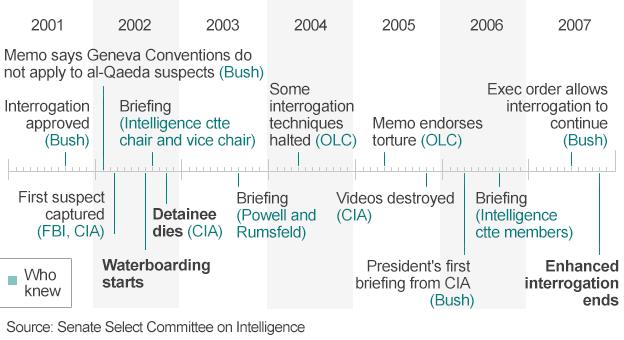CIA interrogation report: Who knew what when?
- Published

OLC is the Department for Justice Office of Legal Counsel
September 2001: After the 9/11 attacks, President George Bush authorises the capture, detention and interrogation of al-Qaeda suspects.
February 2002: President Bush signs an executive order which says the Geneva Conventions - which prohibit mutilation, cruel treatment and torture - do not apply to al-Qaeda or Taliban suspects.
March/April: The first suspect, Abu Zubaydah, is captured in Pakistan and transferred to CIA custody for interrogation by the FBI and CIA.
August: Waterboarding starts. The justice department's Office of Legal Counsel (OLC) issues a memo saying harsh interrogation techniques can be justified in certain circumstances. It also approves certain coercive techniques against Abu Zubaydah - but the Senate report says it did not attempt to verify any of the information it received from the CIA.
September: According to the Senate report, this is the first time leaders of the House Intelligence Committee are briefed on the CIA's techniques. The CIA did not respond to requests for extra information. The committee does not have its own records on this briefing.
November: Detainee Gul Rahman dies at a so-called black site outside the US.
March 2003: Khalid Sheikh Muhammad captured. He is subsequently waterboarded 183 times.
September: CIA briefs Defence Secretary Donald Rumsfeld and Secretary of State Colin Powell on enhanced interrogation techniques.
May 2004: CIA inspector general's report on enhanced interrogation techniques raises questions about the effectiveness of some of the CIA's methods, like waterboarding.
June-Dec: OLC withdraws earlier memo justifying enhanced interrogation, but advises that techniques do not violate anti-torture statute. Issues new memo in December questioning whether enhanced interrogation has proved effective, enhanced interrogation techniques are temporarily suspended.
During 2004, 113 men are detained and questioned. In total, 119 men are arrested and questioned.
May 2005: Newly-appointed head of OLC issues a new memo endorsing the use of enhanced interrogation techniques to obtain what it describes as "otherwise unavailable actionable intelligence" essential for the US to disrupt terror threats.
November: Videotapes depicting the use of the CIA's interrogation techniques, including waterboarding, are destroyed.
December: Congress passes Detainee Treatment Act prohibiting the use of "cruel, inhuman, or degrading treatment or punishment" against detainees of the US government.
April 2006: President Bush receives his first detailed briefing about the enhanced interrogation techniques, according to the Senate report. By this time 38 of the 39 detainees identified as having been subject to enhanced interrogation techniques have already been questioned.
July: Supreme Court ruling that Geneva Conventions do apply to al-Qaeda suspects and that detention at Guantanamo must comply with the conventions.
September: Members of the Intelligence Committee are briefed on the CIA's detention programme for the first time. Later the same day, Mr Bush reveals details of the programme in a public news briefing.
October: Congress passes Military Commissions Act, which provides that particular violations of the Geneva Conventions are subject to criminal prosecution under the War Crimes Act.
July 2007: President Bush signs an executive order which authorises the CIA's continued use of certain interrogation practices.
November: Enhanced interrogation techniques end, according to Senate report.